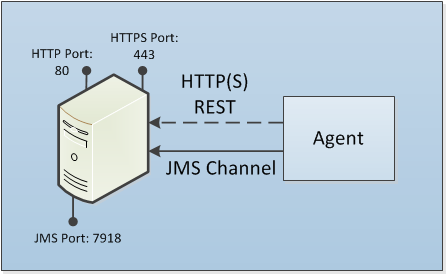
Most agent communication is done with JMS, but some agent activities—posting logs, transmitting test results, or posting files to Codestation, for example—use the web tier via HTTP(s) as needed. The JMS channel is Serena Release Automation's primary control channel; it's the channel the server uses to send agent commands. By default the server listens on only three ports: port 7918 for JMS, 8080 for HTTP, 8443 for HTTPS.
The agent monitor service uses JMS for all server communications and for sending commands, such as "run step," to the worker process. The worker process uses JMS for system communications, and HTTP REST services when performing plug-in steps or retrieving information from the server.
Stateless server-agent communication provides significant benefits to performance, security, availability, and disaster recovery. Because each agent request is self-contained, a transaction consists of independent message which can be synchronized to secondary storage as it occurs. Either endpoint–server or agent∇can be taken down and brought back up without repercussion (other than lost time). If communications fail mid-transaction, no messages are lost. Once reconnected, the server and agent automatically determine which messages got through and what work was successfully completed. After an outage, the system synchronizes the endpoints and recovers affected processes. The results of any work performed by an agent during the outage are communicated to the server.

In the "Stateless Communication" figure, the arrow represents the direction in which communication was established, but the flow can be in both directions with JMS.